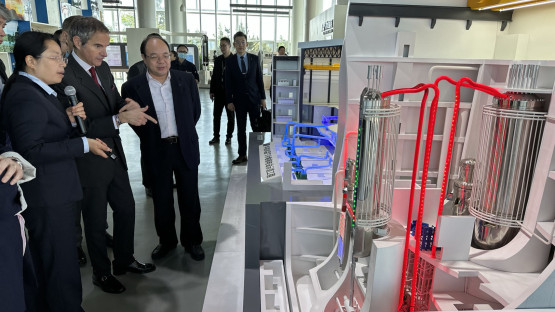Around the world, about 60 nuclear power reactors are under construction, and more than 400 are in operation. While China comes in third for nuclear power generation today – after France and United States of America – by 2030, the country is expected to lead the world in installed capacity of nuclear power. “The speed of China’s growth of nuclear power is remarkable, from the first nuclear reactor that connected to the grid in 1991 to the 55 nuclear reactors in operation today,” said Rafael Mariano Grossi, IAEA Director General. Mr Grossi was in China this week and met with several high-level officials and visited nuclear facilities and institutions in Beijing, Shandong and Shanghai.
China is ranked first for the number of nuclear power reactors under construction; it has 22 reactor units under construction, concentrated along the east and south coasts. By 2035, China’s nuclear power generation will account for 10 per cent of the country’s electricity generation, according to the latest Blue Book of China Nuclear Energy Development Report.
“China is a leader in the promotion of the peaceful uses of nuclear energy in terms of installed capacity and technology. This impressive development is showcased by Shidaowan Nuclear Power Plant,” Mr Grossi said, during his visit to Shidaowan, also known as Shidao Bay, in Shandong province in eastern China on Thursday.
“Shidaowan’s 200 MWe high-temperature gas-cooled reactor (HTGR) has unique design features that make it more efficient and inherently safe, and it has great potential to help meet net zero goals,” Mr Grossi added. The HTGR first connected to the grid in December 2021. Construction of two CAP1400 pressurised water reactor units is also under way at Shidaowan.
In 2020, President Xi Jinping pledged to transform China from the world’s leading CO2 emissions producer to a carbon-neutral country by 2060. “As a clean, low-carbon and efficient base-load energy source, nuclear power plays an important role in the achievement of the UN 2030 Agenda for Sustainable Development. It is also an important option for China to secure the energy supply, optimize the energy mix, and achieve the goals of peak carbon emissions and carbon neutrality,” wrote Zhang Kejian, Chairman of China Atomic Energy Authority, in the IAEA’s Nuclear Energy for a Net Zero World.
China’s nuclear power industry has become self-sufficient in reactor design and construction, as well as in the manufacturing of nuclear components and equipment. Mr Grossi visited the Shanghai Nuclear Engineering Research & Design Institute (SNERDI) and Shanghai Electric (SEC), one of China’s main nuclear power equipment companies, on Thursday. “The nuclear industry in China is shaping the future of nuclear. SNERDI’s capabilities in the design of advanced nuclear technology are an excellent example of the bright future of nuclear, while SEC is enabling a reliable and clean energy future in China and beyond, through its research and development and manufacturing of a range of nuclear power products,” Mr Grossi said.
On Friday, the Director General met Qian Zhimin, Chairman of State Power Investment Corporation (SPIC). SPIC owns a number of nuclear power plants under construction and in operation. “SPIC is one of the key industrial actors driving China’s dynamic developments in nuclear and an excellent example of the integration of energy systems,” Mr Grossi said.
Gu Jun, General Manager of China National Nuclear Corporation (CNNC) and Mr Grossi also shared an important exchange about the country’s civil nuclear programme and perspectives.
Earlier this week, Mr Grossi visited the China Institute of Atomic Energy, the main research institute of CNNC, where he met with researchers and discussed the role of nuclear technology to address global challenges. CNNC is a founding member of the Group of Vienna, Mr Grossi’s initiative that unites major players in the nuclear industry to support the IAEA in its mission to accelerate and enlarge the contribution of nuclear technologies to meet environmental, social and economic goals and to improve the health and well-being of people.








